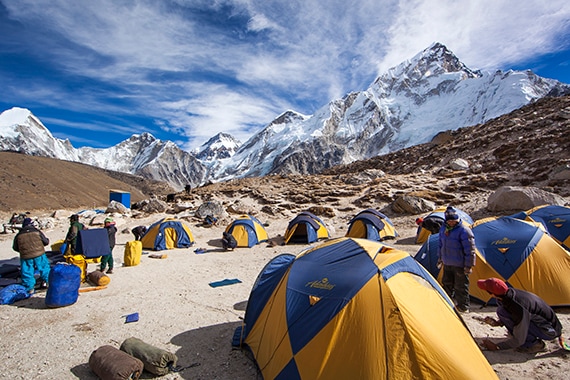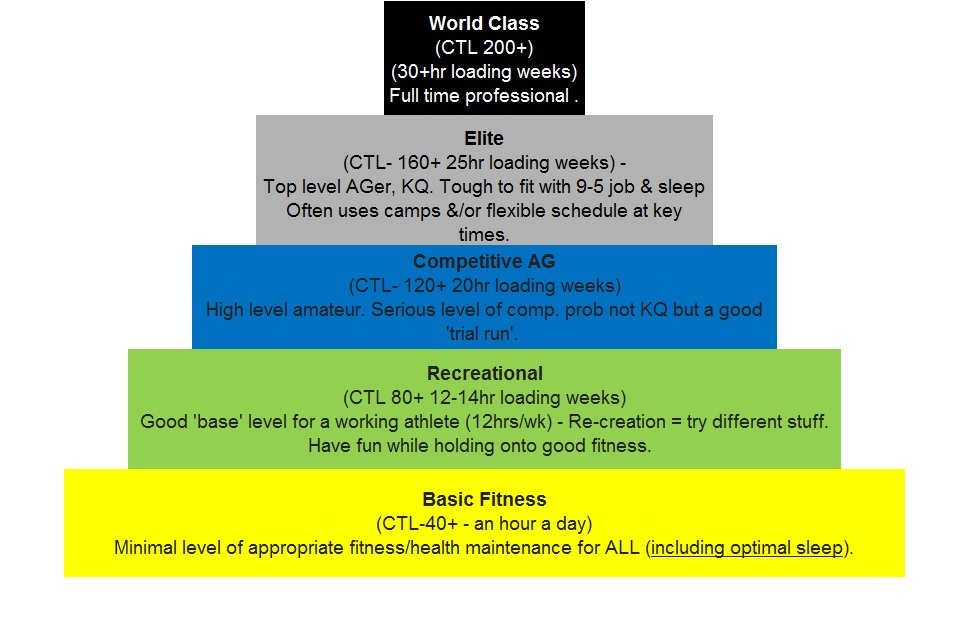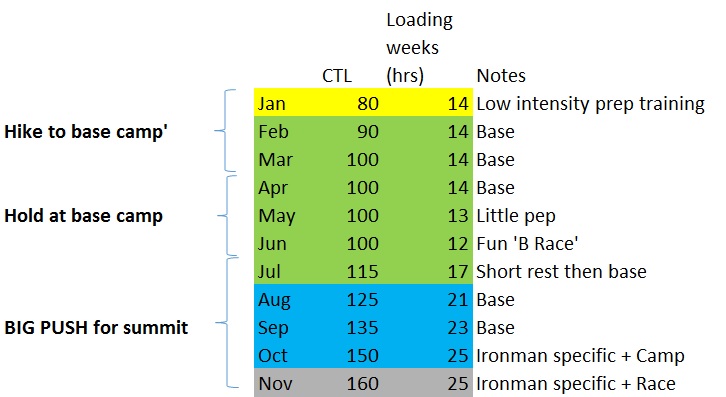Some thoughts on life balance:
Where is your fitness 'base camp'?
Alan Couzens, MS (Sports Science)
Jan 28, 2016

This is a bit of a random post of things that have been on my mind as I reflect on 2015 and another year of high performance coaching.
I’ve noticed a bit of a shift over the last few years in the level of athlete that I’m working with and also the intensity & drive that they bring to the table. The strange thing is, the goal level performance for the majority of the athletes I work with hasn’t changed – Qualify for the Ironman World Championships. It’s just getting harder!
My October 2014 tweet below reflects that change…
Average CTLmax of my Age Group #Kona Qualifiers this year = 156. Fifteen higher than two years ago! #NotGettingAnyEasier #TheTimeIsNow
— Alan Couzens (@Alan_Couzens) October 8, 2014And while I haven’t run the numbers, my gut says I would see a similar trend continuing if I went back to my 2010 qualifiers, i.e. over the last 5 years, the level of training load of the guys I’m seeing qualify has gone up by a good 30-40TSS/d. In real world terms, almost an hour a day extra of training!
Aussie swim coach Bill Sweetenham talks about “Breakpoint volume”, i.e. the maximal sustainable volume that an athlete can manage. Obviously this changes with the context of an athlete’s life/environment. An athlete in a national training center is going to have a different ‘breakpoint volume’ to an age grouper starting a new family or working 10hr days to climb the corporate ladder!
When I started coaching competitive age group triathletes, qualifying volume was challenging for a working athlete but below what I'd consider ‘breakpoint volume’ for those with a (albeit disciplined) normal, stable 9-5 life. Now, I’m not so sure...
Just doing the math, a CTL of 150+ is going to amount to a good number of loading weeks in excess of 25hrs & a majority of training days over 3hrs (I outlined some ‘basic weeks’ for my 2015 qualifiers here). Let's break it down: 3-4hrs of training, 9-10hrs of sleep, 3hrs for meals/prep, 8hrs of work, 2hrs of commuting. The math just doesn't add up! The reality is, unless you’re abnormally talented, qualifying for Kona these days is going to represent a periodic departure from a 'normal' life. This may be in the form of frequent getaway camps, it may be in the form of a flexible work schedule but for most, 4hr training days + work + sleep + family time + good nutrition just isn't all going to fit at the same time.
The best athletes that I work with relish & take pride in this departure from living a normal life. However, the mental strength of these high level athletes & their (chronic) willingness to be 'all in, all the time' can also be their greatest weakness. These guys/gals don't do anything by halves. However, sometimes coming back to 'halves' is the best thing that you can do to sustain your long term development as an athlete & your long term health!
There is a disturbing pattern among some very high level competitive athletes that I've worked with - they go ‘all in’ for a period until stuff starts falling apart in other areas & then they are 'all out' of sport all together as they swing widely back in the other direction (e.g. career) to ‘balance things out’. These wide swings aren’t optimal in a lot of ways. It’s certainly not optimal to your long term development as an athlete to keep coming back to ‘starting from scratch’. It’s not good for your health to swing between virtual couch potato & athletic training ‘at the limit’ & it’s just a plain stressful way to live to keep trying to balance those spinning plates holding together a life so packed that it's bursting at the seams.
I think there’s a better, more sustainable, way….
Life-long sport is important. These days, in the absence of deliberate ongoing sport/physical training, as a person living in a 'developed' society, you’re just not going to move enough to maintain your health & a basic level of functional fitness. So, some deliberate, consistent (every day) physical activity must take place. Back in the day, this just happened with the physical nature of daily tasks but now, its best proxy is training for a sport!
The big challenge that I see for many 'serious' athletes is to keep a sufficiently broad definition of what constitutes 'training for sport' & not base it on your long term performance goals or where you might have been in the past & fall prey to the 'if it's not *this* it's not 'real training' therefore it's not worthwhile' mindset. Rather, it’s important (to your long term health) to figure out a level of physical training that represents your firm minimum, what I’m calling your ‘fitness base camp’ & to have a basic training plan with fixed slots in the weekly schedule built around that.
I love the analogy of a ‘base camp’. I think it’s incredibly fitting. You hear stories of the fun atmosphere and camaraderie among the adventurers as they meet at Everest base camp before the ‘serious’ climbing begins. Hikers reaching the peak of their travel meet with climbers resting before heading further up to have fun, exchange stories & share inspiration. And when the 'serious climbing' does begin, it begins slowly – ‘testing the waters’ at progressively higher altitudes while always returning to base camp to recover and acclimate that higher level. The same attitude can be carried across to high performance sport and our deliberate & brief ‘pushes for the summit’…

So, where does your base camp sit on the mountain?
What level of fitness is sustainable & fun & fulfilling the physical expression of you as a human being over the long term?
You don't have to decide on one. Just like the Everest climbers, it’s smart to move around the mountain. To go up a level for a bit, test the waters and then come back down to a healthy, low stress level to acclimate. The novice climbers resist these 'backward steps' but the experienced know that these intelligently planned retreats are the only surefire way to move further up the mountain.
The most important thing is not to go in so deep at any one stage that you have to come all they way back to sea level to recover. Stay on the mountain.
Moving away from the metaphor into some more practical guidelines. When planning your year, give some honest, considered, thought to your greater life context at various points in the year. Think about a realistic ‘base camp’ level and then think about possible windows of opportunity where you may have more time at your disposal to push up a level or even make a run for your summit.
Beyond a philosophy, the above is a periodization strategy of stringing together shorter ‘builds’ that line up with your life as a whole. After identifying your ‘base camp’ & ‘summit attempt’ for the season ahead, I recommend dividing your year up into these levels of preparation - 2 or 3 levels/'tiers' of 12-24 weeks. Each in accordance with the greater context of your life. Be sure to include new and exciting challenges sprinkled at each level. If you’re a long term ‘elite’ Ironman athlete, perhaps you don’t want to include an Ironman in your ‘re-creational’ phase but perhaps it’s been a while since you raced a 5K? Or a mountain bike race? Or an obstacle race? You get the picture...

The above represents a sample plan for an athlete who might have a busier period of work mid-year. Volume builds early, holds steady during the busy period before making a push for a competitive goal late year.
A fun 'B race' - something that ideally addresses one of the athlete's physiological weakpoints AND something that the athlete is motivated for (& something new & fun that they don't have a lot of comparative benchmarks for) is included mid-year to keep a proverbial 'carrot' dangling out there and to keep them motivated. This structure represents a significant departure from the 'chronic IMers' plan of having the pressure of 2-3 competitive Ironman races crammed throughout each year until burnout(!) The alternative, sustainable strategy is worth considering in terms of 'pacing your passion' for the long run.
Regardless of how you play it, the most important guiding principle is - if you find the air a bit thin after heading up a level, don’t fall off the mountain! Come down to a low stress, fun level of training, regroup & make another run when you feel inspired to do so. And while you’re at base camp, look around a bit. I can attest that there are worse ways to spend your days than staying fit & healthy while hanging out with fellow athletes in the shadow of the peaks.
Train smart (& for your whole life),
AC
TweetDon't miss a post! Sign up for my mailing list to get notified of all new content....
